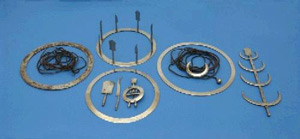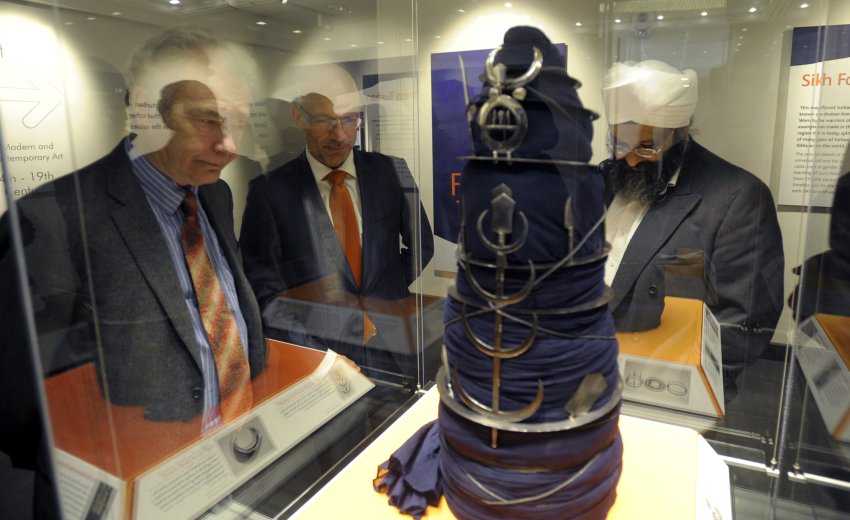 Following on from the story of the remarkable Bhai Maharaj Singh Collection at the British library, www.punjbaheritage.org is delighted to highlight another fascinating item from the UK national collections. This is a little known, but highly important Sikh "Nihang/Akali" turban, in blue cloth with steel blades and quoits; the whole arranged over a wooden cone for display. One of the steel weapons is said to be stamped with the insignia the Sikh police battalion, 'Rattray's 45th', founded in the 1850s.
Following on from the story of the remarkable Bhai Maharaj Singh Collection at the British library, www.punjbaheritage.org is delighted to highlight another fascinating item from the UK national collections. This is a little known, but highly important Sikh "Nihang/Akali" turban, in blue cloth with steel blades and quoits; the whole arranged over a wooden cone for display. One of the steel weapons is said to be stamped with the insignia the Sikh police battalion, 'Rattray's 45th', founded in the 1850s.
According to historian and author Parmjit Singh, the turban is a 'Naina Singhia dhirmukhia dastaar bunga' - 'dastaar bunga' being the tall fortress turbans of the Nihang Sikhs; the term 'dhirmukhia' refers to the presence of the 'arrow-headed' quoit with attached swords and daggers. This feature is especially unique as neither V&A or Royal Armouries ones have it).
One of the other insignia (the smaller circular one) of particular interest is the emblem of the Sikh police battalion, 'Rattray's 45th', founded in the 1850s. The double edged sword blade, repeated throughout the metalwork, is a very important Sikh symbol, called a 'khanda'. The central ornament is called a gajgah - this is fairly typical – although unusual to find. The steel wire is absolutely typical and was used to wind around the turban, holding elements in place.
The quality of the metal work is less fine that the V&A turban on display which has gilding.

 'Display' turbans like this were used to show off the metal work. People liked to collect or treasure the turban ornaments of famous warriors, and would display them like this. There are examples of such display turbans referred to in the great exhibitions of 19th century Europe as well as in important Sikh temples in India.
'Display' turbans like this were used to show off the metal work. People liked to collect or treasure the turban ornaments of famous warriors, and would display them like this. There are examples of such display turbans referred to in the great exhibitions of 19th century Europe as well as in important Sikh temples in India.
The turban cloth is in very poor condition, friable and easily crushed to powder. The metal is in need of a clean but is undamaged. Commenting on the condition of the fabric, conservator M Pullan said: “The most complicated bit is working out what the arrangement of the fabric at the top of the turban is - whether it has a 'farla' or not - both are right, but apparently if there is a 'top knot' it denotes the rank of 'Akali nihang', and if not, it is just 'nihang' (and should not be called akali) - I am hoping that as I explore the remaining 'chaos' of fabric more, the original structure will become apparent!"
The Akali turban has been in the BM collection for many years, possibly from as early as the 19th century. It is part of the Asian Dept's collection of arms and armour, transferred from its old home in the early 1980s.
-By Amandeep Madra

